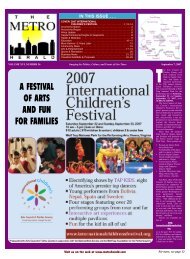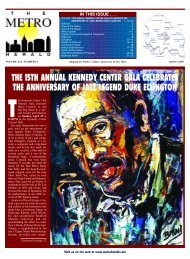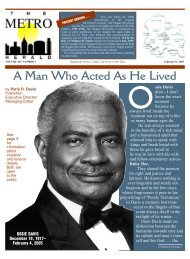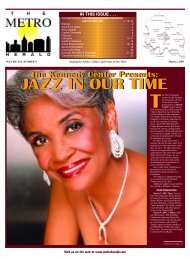happy father's day 2008 - The Metro Herald
happy father's day 2008 - The Metro Herald
happy father's day 2008 - The Metro Herald
Create successful ePaper yourself
Turn your PDF publications into a flip-book with our unique Google optimized e-Paper software.
AROUND THE NATION<br />
June 13, <strong>2008</strong><br />
INSTITUTE FOR INTERNATIONAL<br />
PUBLIC POLICY ANNOUNCES<br />
FELLOWSHIP CLASS FOR <strong>2008</strong><br />
<strong>The</strong> Institute for International<br />
Public Policy (IIPP), a program<br />
of the UNCF Special Programs<br />
Corporation (UNCFSP) announced<br />
that 32 outstanding young men and<br />
women from across the country have<br />
been selected for the 14th Cohort of<br />
the IIPP Fellowship—one of the nation’s<br />
most prestigious programs for<br />
minority students interested in pursuing<br />
careers in international affairs.<br />
Each of the 32 IIPP Fellows will receive<br />
scholarships and services totaling<br />
nearly $100,000 over a five-year<br />
period, a commitment of $3.2 million.<br />
<strong>The</strong> IIPP <strong>2008</strong> class represents 26<br />
different colleges and universities, including<br />
seven Historically Black Colleges<br />
and Universities: Dillard University,<br />
Johnson D. Smith University,<br />
Spelman College, Wilberforce University,<br />
Howard University and Jackson<br />
State University. Selection as an IIPP<br />
Fellow is highly competitive and based<br />
on a record of remarkable academic<br />
achievement, evidence of leadership<br />
potential and commitment to a career<br />
in global affairs. A complete list of the<br />
Fellows, their educational institutions<br />
and hometowns is below.<br />
“<strong>The</strong> incoming Fellows are one of<br />
the most diverse groups the IIPP has<br />
ever had,” said Darryl Crompton, Director<br />
of the IIPP. “Our students are<br />
from almost every region of the country<br />
and come from small liberal arts<br />
colleges, Ivy League universities, Hispanic-Serving<br />
Institutions and Historically<br />
Black Colleges and Universities.<br />
What brings them together is their interest<br />
and commitment to a career in<br />
international affairs.”<br />
Over the next seven weeks, the students<br />
will participate in the rigorous<br />
seven-week Sophomore Summer Policy<br />
Institute (SSPI) hosted at Spelman<br />
College in Atlanta, Georgia. <strong>The</strong> SSPI<br />
introduces Fellows to the basics of international<br />
policy development, foreign<br />
affairs, cultural competence, careers<br />
in these fields, and options for<br />
graduate study. Over the next five<br />
years the Fellowship will include study<br />
abroad during their junior year, intensive<br />
foreign language training, internships<br />
tied to their areas of interest and<br />
graduate study<br />
US LIFE EXPECTANCY TOPS 78<br />
AS TOP DISEASES DECLINE<br />
For the first time, U.S. life expectancy<br />
has surpassed 78<br />
years, the government reported,<br />
although the United States continues to<br />
lag behind about 30 other countries in<br />
estimated life span.<br />
<strong>The</strong> increase is due mainly to<br />
falling mortality rates in almost all the<br />
leading causes of death, federal health<br />
officials said. <strong>The</strong> average life expectancy<br />
for babies born in 2006 was<br />
about four months greater than for<br />
children born in 2005.<br />
Japan has the longest life expectancy—83<br />
years for children born<br />
in 2006, according to World Health Organization<br />
data. Switzerland and Australia<br />
were also near the top of the list.<br />
“<strong>The</strong> international comparisons are<br />
not that appealing, but we may be in the<br />
process of catching up,” said Samuel<br />
Preston, a University of Pennsylvania<br />
demographer. He is co-chairman of a<br />
National Research Council panel looking<br />
at why America’s life expectancy is<br />
lower than other nations’.<br />
<strong>The</strong> new U.S. data, released<br />
Wednes<strong>day</strong>, come from the National<br />
Center for Health Statistics. It’s a preliminary<br />
report of 2006 numbers, based<br />
on data from more than 95 percent of<br />
the death certificates collected that year.<br />
Life expectancy is the period a child<br />
born in 2006 is expected to live, assuming<br />
mortality trends stay constant.<br />
<strong>The</strong> 2006 increase is due mainly to<br />
falling mortality rates for nine of the 15<br />
leading causes of death, including heart<br />
disease, cancer, accidents and diabetes.<br />
“I think the most surprising thing is<br />
that we had declines in just about every<br />
major cause of death,” said Robert Anderson,<br />
who oversaw work on the report<br />
for the health statistics center.<br />
<strong>The</strong> overall death rate fell from 799<br />
per 100,000 in 2005 to about 776 the<br />
following year.<br />
Health statisticians noted declines<br />
Visit us on the web at<br />
www.metroherald.com<br />
of more than 6 percent in stroke and<br />
chronic lower respiratory disease (including<br />
bronchitis and emphysema),<br />
and a drop of more than 5 percent in<br />
heart disease and diabetes deaths. Indeed,<br />
the drop in diabetes deaths was<br />
steep enough to allow Alzheimer’s disease—which<br />
held about steady—to<br />
pass diabetes to become the nation’s<br />
sixth leading cause of death.<br />
<strong>The</strong> U.S. infant mortality rate<br />
dropped more than 2 percent, to 6.7 infant<br />
deaths per 1,000 births, from 6.9.<br />
Perhaps the most influential factor<br />
in the 2006 success story, however,<br />
was the flu. Flu and pneumonia deaths<br />
dropped by 13 percent from 2005, reflecting<br />
a mild flu season in 2006, Anderson<br />
said. That also meant a diminished<br />
threat to people with heart<br />
disease and other conditions. Taken together,<br />
it’s a primary explanation for<br />
the 22,000 fewer deaths in 2006 from<br />
2005, experts said.<br />
U.S. life expectancy has been<br />
steadily rising, usually by about two to<br />
three months from year to year. This<br />
year’s jump of fourth months is “an<br />
unusually rapid improvement,” Preston<br />
said.<br />
Life expectancy was up for both<br />
men and women, and whites and<br />
blacks. Although the gaps are closing,<br />
women continue to live longer, almost<br />
to 81, compared to about 75 for men.<br />
Among racial categories, white women<br />
have the highest life expectancy (81<br />
years), followed by black women<br />
(about 77 years), white men (76) and<br />
black men (70). Health statisticians<br />
said they don’t have reliable data to<br />
calculate Hispanic life expectancy, but<br />
they hope to by next year.<br />
Increases in female smoking are a<br />
major reason that men’s life expectancy<br />
is catching up with the women’s, Preston<br />
said. Improvements in the care of<br />
heart disease—a major health problem<br />
for black Americans—helps explain an<br />
improving racial gap, he said.<br />
About 2.4 million Americans died<br />
in 2006, according to the report.<br />
PRISONWORLD MAGAZINE OPENS ITS DOORS TO ADVERTISERS<br />
Dawah International, LLC has<br />
introduced and released its one<br />
of a kind magazine for prisoners.<br />
Prisonworld Magazine is published<br />
on a seven-issue basis in order<br />
to communicate with those behind the<br />
wall. It is very unique in conception<br />
and the only magazine especially for<br />
the prison system that showcases poetry,<br />
letters of inspiration, thoughts,<br />
comments, and opinions, individually<br />
and collectively, of inmates.<br />
<strong>The</strong> magazine is tailored for the incarcerated,<br />
but is available to the general<br />
public for purchase and participation.<br />
Dawah has formulated a pen pal<br />
service where men and women across<br />
the United States who have a desire to<br />
communicate with someone in prison<br />
can do so in anonymity. As well, inmates<br />
can communicate with one another<br />
through free pen pal ads. Inmates<br />
can become VIP members with special<br />
privileges. <strong>The</strong> magazine also offers<br />
trivia and scrabble contests, surveys,<br />
religious content, and much more.<br />
Prisonworld Magazine now ships<br />
to over 400 institutions, state and federal,<br />
in 32 states. “Since it is free to the<br />
institution’s libraries, we can estimate<br />
our readership at approximately<br />
350,000 per month,” says Rufus<br />
Triplett Jr., Editor. <strong>The</strong> magazine also<br />
has a large “free world” subscriber<br />
SAFEWAY’S EASTERN DIVISION OFFERS<br />
$4 GENERIC DRUGS FOR THE MOST<br />
COMMONLY PRESCRIBED MEDICATIONS<br />
Safeway to<strong>day</strong> announced a discount prescription program that will price<br />
more than 300 of the most commonly prescribed generic medications at<br />
$4 for a 30-<strong>day</strong> supply. <strong>The</strong> $4 Generic Drug Program—effective at all<br />
Safeway in-store pharmacies in Washington, D.C., Maryland, Virginia and<br />
Delaware—offers a savings to customers purchasing medications that treat<br />
the most common conditions, such as diabetes, asthma, chronic pain, thyroid<br />
and heart health issues.<br />
<strong>The</strong> program began recently at 115 in-store Safeway pharmacies throughout<br />
the region.<br />
Generic drugs contain the same active ingredients as their name-brand<br />
counterpart, but cost less. A complete list of prescriptions available under the<br />
$4 Generic Drug Program can be obtained at Safeway pharmacies or by calling<br />
the Safeway Customer Service Center at 1-800-723-3929.<br />
Current Safeway pharmacy customers will realize the new pricing with<br />
their next refill. New customers can bring a written prescription or transfer a<br />
prescription by simply calling their local Safeway pharmacy. Customers can<br />
also transfer a prescription online at Safeway.com in the “Wellness Center”<br />
section under “Pharmacy.”<br />
For more information, visit www.safeway.com.<br />
base. Many people find the magazine<br />
interesting because of its positive messages,<br />
humor, resources and trivia. <strong>The</strong><br />
magazine is highly demanded and anticipated<br />
in all of the institutions.<br />
<strong>The</strong> magazine has recently opened<br />
its publication to advertisers. In keeping<br />
with the attitude of giving its readers<br />
what they want, the magazine is<br />
seeking typing services, gift stores,<br />
greeting card wholesalers, pen pal/<br />
MYSPACE services, lawyers/paralegals,<br />
jewelry stores, audio books/bookstores,<br />
authors (self-published, African-<br />
American, self-help, etc) and entrepreneurial<br />
services as advertisers.<br />
Jenny Triplett, Editor-in-Chief, says,<br />
“We receive several letters every week<br />
requesting all kinds of services. Even<br />
though we would like to, we cannot<br />
handle all of the prisoners needs. We<br />
know there are people out there who<br />
are willing to think outside the box.”<br />
Prisonworld Magazine offers better<br />
than competitive rates and an extremely<br />
unique target market. With over 2.2 million<br />
incarcerated, anyone who advertises<br />
in the magazine has a direct link to<br />
a community with its own market share.<br />
Dawah is a family owned and operated<br />
company established to bring a<br />
positive vibe to the prison community.<br />
<strong>The</strong> owners are originally from Michigan,<br />
with ties in Toledo, Ohio and<br />
Florida, and have been based in the Atlanta<br />
area for over 15 years. When<br />
asked the question what would make<br />
you start a magazine like this, the owners<br />
respond intelligently “We hope to<br />
bring new and different ideas to the<br />
multimedia game as well as enlighten<br />
views and perceptions of an uninformed<br />
and forgotten society.”<br />
THE METRO HERALD 7

















